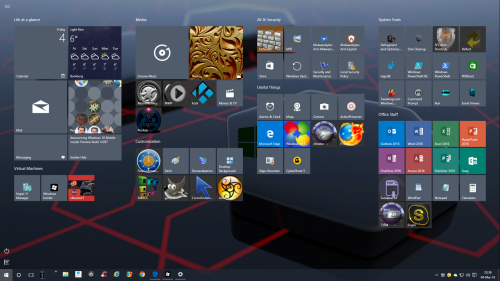Start menu: Difference between revisions
Gabegriggs1 (talk | contribs) |
Gabegriggs1 (talk | contribs) |
||
| Line 25: | Line 25: | ||
== Rebirth of the Start menu (Windows 10)== | == Rebirth of the Start menu (Windows 10)== | ||
[[image:Windows10StartMenu.jpeg|500px]] <br> | [[image:Windows10StartMenu.jpeg|500px]] <br> | ||
Windows 10 offically has a start menu again, after a huge outpouring of hate to the critics against the start screen. | Windows 10 offically has a start menu again, after a huge outpouring of hate to the critics against the start screen. | ||
| Line 32: | Line 33: | ||
This shows that the Start menu probably will never die , rather it will be improved upon with successive versions of Windows. | This shows that the Start menu probably will never die , rather it will be improved upon with successive versions of Windows. | ||
=== Start Menu Now === | |||
[[File:Screenshot 20 .0.png|500px]] | |||
<br> | |||
===Start Menu Full-Screen=== | |||
[[File:Image 001.png|500px]] | |||
Revision as of 02:30, 23 October 2018
The Start menu is an interface , part of Windows Explorer , which was introduced back in Windows 95 as a replacement for Program Manager. Now , it's one of the most important part on it , so much that there was major criticism when it was removed in Windows 8 and replaced with the Start Screen. Now the Start Screen looks ready to come back , as the pre-release builds of Windows 10 show it back , a mix of Windows 7 and 8.1.
It has grown , changed and even removed(Windows 8/8.1) , and there's a long and interesting history on it.
The Early Days(Windows 95 , 98 , Me , NT 4 and 2000)
The start menu is a user interface feature than began in Windows 95. The start menu began August 1995 at the release of Windows 95. The Start menu at that time was quite different to what you'll usually see in later versions of Windows:-
File:98start.gif
You could actually get such a mode in Windows XP and Vista as well by choosing the Classic Start option.
In its early stages it only had a list containing Programs, My Documents, Help, Run and the Shutdown option. The Start menu quickly become popular because of it's easiness and quickness on finding programs and files.
The Redesign(Windows XP)
File:Xpstart2.gif
Windows XP took over what was there and improved it. It widened the Start menu and now contains 2 columns. The first column lists the programs you've accessed most. The second column your personal folders, Run, Control Panel, Internet Programs and the option to turn off , log off or restart the PC. It also showed the name and picture of the user on the top.
Despite this , Windows XP(and Vista) left an option to return back to the Windows 95-style Start menu.
Improving on Start(Windows Vista and 7)
File:7start1.png
After that Vista came with more on the start menu than eve before , improving on what was already there. You could now turn off the computer from the Start menu itself. And Search was also integrated into the Start menu. These improvements were maintained in Windows 7.
Windows 7 introduced Jump Lists , which shows the recent webpages/items that you used/opened in the recent programs. You could even pin the items.
File:8.1start1.jpg
This is when Microsoft introduced the Start screen in Windows 8 and removed the start menu(which was the first in the history) , apparently to make it more tablet friendly and to fit in with the Metro design language. This move by Microsoft was criticized heavily.
Many people liked the Start menu so much that they installed replacements like Start8 which provided a Windows 7 styled Start menu and even some Start replacements were bundled with some PC's.
Windows 10 offically has a start menu again, after a huge outpouring of hate to the critics against the start screen.
Instead of simply providing the Windows 7 styled start menu , Microsoft took parts of the Start screen of windows 8.1 such as rearrangeable live tiles and mixed them together for Windows 10's Start Menu.
The left column has the same purpose as before , while the right column now serves a different purpose. It consists of the tiles which was present in Windows 8 and 8.1. You could do everything which you could do on Windows 8.1 on the tiles , such as rearranging , increasing/decreasing the size of the tiles and also Live Tiles.
This shows that the Start menu probably will never die , rather it will be improved upon with successive versions of Windows.
